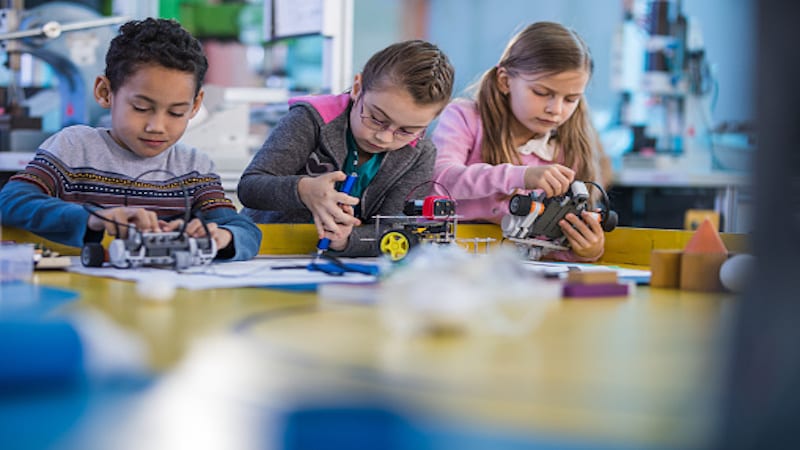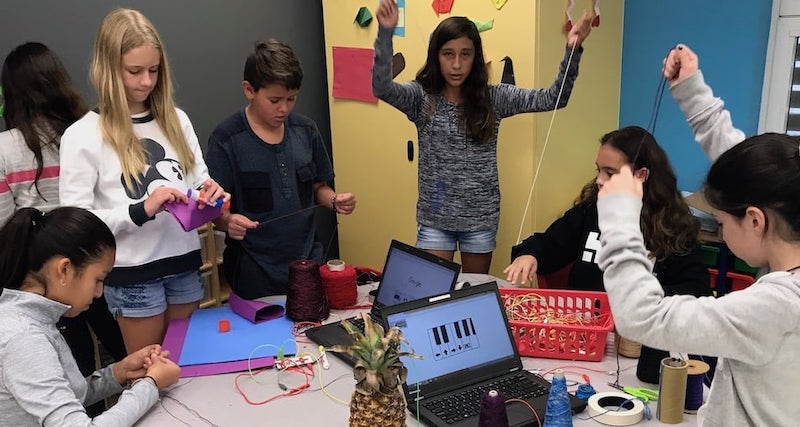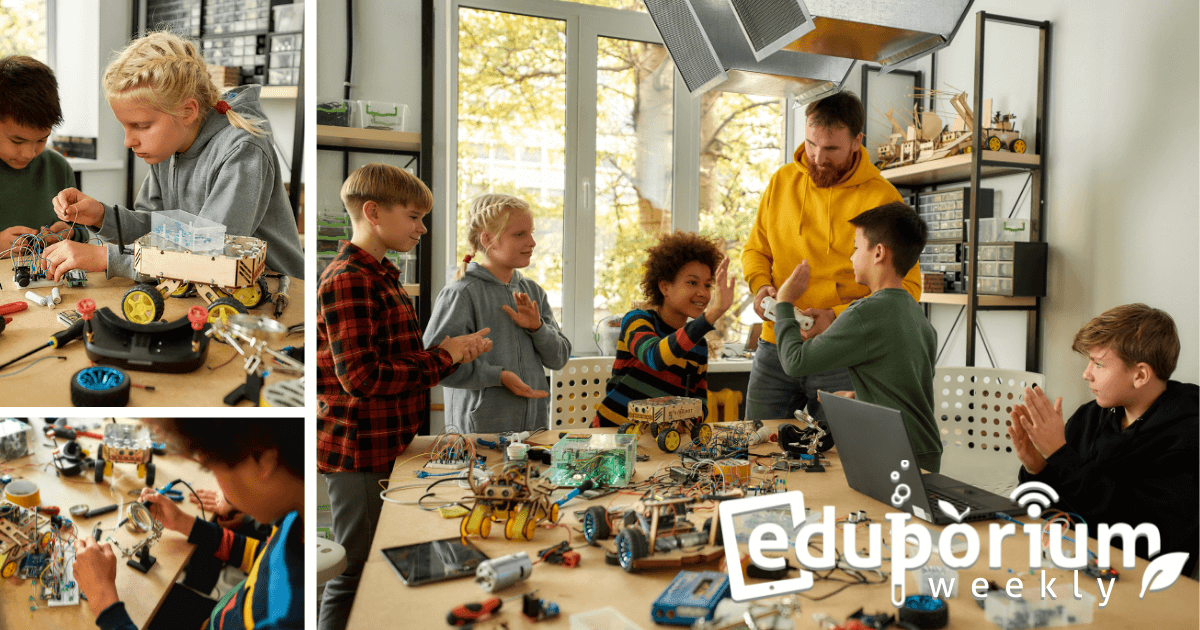It's a pretty broad question and one that elicits different answers from different people. There's a number of reasons as to why makerspace experiences provide everyone from school children to skilled manufacturers with value, intrigue, and excitement. And, though the reasons why makerspaces are important are certainly extensive, they often tie back to a pre-determined mission. In schools, particularly, maker learning provides students with the chance to design, plan, tinker, create, destroy, and repurpose. Plus, in the real world—as we saw during the pandemic—makers can also help serve their communities. So, while it might be hard to zero in on exactly why we love makerspaces, we can certainly list some top reasons.
How Students Can Benefit From Makerspaces
Some children learn differently from the majority of their peers and may need an unstructured environment within which to grow. For kids who don't respond well to traditional lectures and tests, mixing in MakerEd opportunities can be a sound strategy. Even for students who are doing well with their academics, maker opportunities can help them build up both their hard and soft skills through hands-on experimentation and discovery. When students get regular time in a makerspace, the range of benefits can potentially transform their success in multiple areas. Plus, educators can personalize experiences for students in all grade levels and students can learn to overcome various challenges with a renewed sense of self.
Specific ways students benefit from makerspaces.
In school makerspaces, students have the chance to work with their hands. As we have preached plenty of times, they can also enjoy the opportunity to connect their hands to their heads and hearts. When bringing these key physical elements of learning together, students tend to engage more deeply with STEM projects since they personally care about what they're creating. Makerspace projects also tend to involve students turning their creative ideas into reality. And, with various maker tools, they can also design new concepts, create updates to existing prototypes, see their ideas make an impact, and more.
How MakerEd impacts achievement.
Further, teachers can work with students to help them create stronger connections with classroom content. In science or history classes, for example, students can use their makerspace time to design and create 3D models. This helps them move from abstract concepts to gaining a deeper understanding of key academic elements. Since it's also very hands-on, maker learning often helps students learn to embrace their failures as well. In maker education, failure is important but sometimes overlooked. Since students are often trying things that are completely new, these missteps are important to ensure they don't get discouraged. Finally, MakerEd experiences help children build key critical thinking and problem solving skills that will serve them well in other subjects as well as in the future.
Creating Greater Equity and Opportunity with Makerspaces
Whether in a school, library, or a public place, makerspaces can help create and foster equitable access to learning. It's also not unheard of for students to miss out on certain hands-on learning opportunities if they don't have access to the proper tools. This is something that the leaders and many advocates of the Maker Movement are certainly aware of. And, their goal of equal access for all has trickled down to the K-12 level. In designing school makerspaces, one of the most common initial goals is creating an environment that's inclusive and welcoming for every student. This is what ultimately leads to equity with every student having access to the same physical and digital tools to create new projects.
Equity lies in the activities.
Once open, makerspaces tend to quickly grow into academic and collaborative hubs within schools. Over time, students will hopefully begin to learn about the transformative opportunities they can provide as well. Whether they're interested in STEAM or not, maker learning spans into many different disciplines. Children can try to design a video game, 3D print a part for a project, build a robot, and even try coding. Since they have such a variety when it comes to activities, framing the school makerspace as a fun and collaborative environment that's built on accessibility shouldn't be too tough. Plus, seeing that there's no need to worry about failure, students may find it easier to try new things, too.
The maker mindset and equity.
Another aspect of MakerEd is the maker mindset. This involves teaching students that opportunities lie in creativity and there are many ways they can achieve success, including design, construction, revision, self-reflection, collaboration, and more. Using this type of mindset also helps students realize the importance of community as well. Once working with their friends in new ways becomes more natural over time, students could also subconsciously create greater equity. When all students are involved and applying the principles of a maker mindset, they can put their creativity into practice, apply critical thinking in problem solving, and gain confidence through collaboration. And, this is great for ensuring equitable maker opportunities for all.

Social-Emotional and Soft Skills Development
Makerspace learning experiences aren't only helpful for students when it comes to hands-on exploration. Sure, they can build a bunch of hard skills through various exploratory experiences but they also benefit in other ways. Even prior to the pandemic, educators had, of course, recognized this importance of students developing soft skills and social-emotional strength. These two areas remain closely related and each of them are relevant in makerspaces. For example, students may be a bit fearful of new technologies or even nervous about developing the skills to succeed in future jobs. In each case, MakerEd challenges help kids see that, through experience, they can apply these unique skills to arrive at the results they need.
How maker learning relates to soft skills.
These experiences can also help boost their social-emotional health by reducing some anxieties they might have about their future. Typically, MakerEd is not for helping students develop tech and invention skills. It's more so for helping them develop skills including adaptability, exploration, communication, collaboration, growth, self-reflection, and others. Commonly referred to as soft skills, they're each relevant competencies that kids could develop through maker experiences. On the other hand, because employers actively search for these skills, we can see how maker learning connects to future readiness. For example, kids might have to work closely with peers and make quick decisions while designing makerspace projects. So, experience in these areas helps them maintain key soft skills moving forward, including those that employers desire.
Makerspaces, SEL, and self-expression.
As for the social-emotional side, students are free to create almost any type of project in the makerspace. These opportunities for self-expression help them learn to articulate their thoughts and opinions in a more creative way. Makerspaces can also resemble many contemporary office settings. They're often very much collaborative and built around "open floor plans" that allow and encourage everybody to interact. Students can get a taste of this fast-paced interactivity in makerspaces and, ideally, become more comfortable with communicating. This even helps them learn how to work with others from different backgrounds. As such, it's a perfect opportunity to learn adaptability and recognize the importance of problem solving, teamwork, and communication when it comes to real-world success. When they do, their social comfortability should improve along the way along with any emotional hesitations.
Why Makerspaces Matter in School Communities
Aside from helping kids express themselves or re-establish social-emotional balance, makerspaces help educators create conditions for success. They also help create many long-term and immediate benefits for students but there are some that we do like to focus on. Inevitably, certain children will become bored with the same repetitive instruction and tests in the classroom. Plus, in alignment with future readiness, they all should be thinking critically, rolling up their sleeves, and actually solving problems. Since we can easily tie maker learning to standards, however, creating school makerspaces seems to be a win-win for educators, students, and administrators.
Designing different makerspace areas.
Often, makerspaces benefit students because of all the new opportunities for exploration. They burst on to the scene a decade or so ago and continue providing various students with a new-age combination of their art and computer classes. In makerspaces, students often use tools like 3D printers or laser cutters when bringing their ideas to life. And, at the same time, educators often design school makerspaces strategically as well. This gives them a chance to create an area for 3D printing, another for low-tech engineering, some space for robotics, a spot for digital or screen-free coding, and so on. The constant energy and vibrance in makerspaces also tends to result in all these different areas merging into one, community-driven space.
Preparing students for the future.
Just as they would strive to do in the classroom, teachers should encourage real-world learning throughout the makerspace. Since students usually love a chance to change things up, MakerEd projects are a perfect option. One reason they'll tend to enjoy these tasks is that it's nearly impossible for them to be passive in a makerspace. They'll truly feel inspired from the get-go and, with so many powerful tools to try out, children can start designing projects right away. It isn't always easy, however, but that's the beauty of it all. Through their makerspace experiences, students can learn the value of persistence, invention, and collaboration as well as how thinking critically helps drive these innovative solutions. Perhaps most significantly, it's those elements of real-world relevance that make school makerspaces so important.

Why Makerspaces Belong in Schools
Despite the effectiveness of MakerEd experiences, not all K-12 students have spent time in a makerspace. Whether they're lacking enough space, leadership, or resources, it is sometimes impossible for teachers to bring one into their school. If you can get one off the ground, however, we'd certainly recommend it. One of the biggest reasons for maker learning is that educators can design equitable and accessible opportunities for each student. Conversely, in the classroom, not every student starts at the same place. Some may have prior knowledge on a topic or struggle to grasp the foundational concepts. In a makerspace, however, pre-existing knowledge isn't a prerequisite for discovery and exploration-based creation.
Using makerspace experiences to enhance overall learning.
Another way to look at it is to focus on the value that comes from restriction-free play and discovery. Often, students can make some of their best discoveries and draw some of the most important connections when they're simply having fun. As we've said, teachers can also choose to connect makerspace projects to the curriculum. Not only can students explore curricular topics in an alternative style, but lots of makerspace projects can also help enrich classroom discussions and lectures. Plus, if you have a makerspace in your library, for example, librarians can collaborate with classroom teachers on activity design. In this situation, it's great to tie MakerEd projects to books and stories. Students could even create scenes, dioramas, and other projects from an important part of the book as one example.
Reinventing traditional learning experiences.
Makerspaces can also help with enhancing school library programs, in particular. Although many school makerspaces are located within the library, they should not prevent students from reading or checking out books. Rather, maker experiences should help enhance their overall library experience by drawing students in. Then, ideally, librarians can help steer them towards books related to some projects that they've worked on. Finally, as education continues evolving, learning experiences are also much more active. It's no longer ideal for students to spend hours quietly working on projects. Oftentimes, it's best for each of them to get up, collaborate with peers, and generate some excitement. And, as you might have guessed, makerspace experiences are perfect for that.
For the latest EdTech, STEM, and 21st century education news, follow us on Twitter and Instagram. Like us on Facebook, too, or sign up for our newsletter for our latest product announcements and offerings. If you have an idea for an Eduporium Weekly theme, send us a message on social media or comment below.



